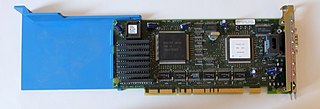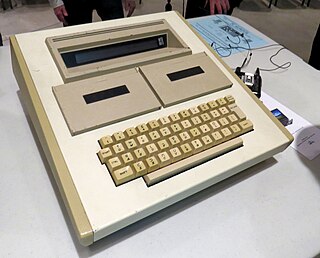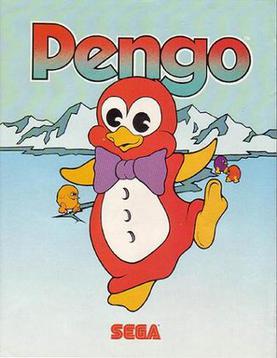Related Research Articles

The MOS Technology 6502 is an 8-bit microprocessor that was designed by a small team led by Chuck Peddle for MOS Technology. The design team had formerly worked at Motorola on the Motorola 6800 project; the 6502 is essentially a simplified, less expensive and faster version of that design.


VAX is a series of computers featuring a 32-bit instruction set architecture (ISA) and virtual memory that was developed and sold by Digital Equipment Corporation (DEC) in the late 20th century. The VAX-11/780, introduced October 25, 1977, was the first of a range of popular and influential computers implementing the VAX ISA. The VAX family was a huge success for DEC–over 100 models were introduced over the lifetime of the design, with the last members arriving in the early 1990s. The VAX was succeeded by the DEC Alpha, which included several features from VAX machines to make porting from the VAX easier.
In computer architecture, 8-bit integers or other data units are those that are 8 bits wide. Also, 8-bit central processing unit (CPU) and arithmetic logic unit (ALU) architectures are those that are based on registers or data buses of that size. Memory addresses for 8-bit CPUs are generally larger than 8-bit, usually 16-bit. 8-bit microcomputers are microcomputers that use 8-bit microprocessors.

Acorn Computers Ltd. was a British computer company established in Cambridge, England, in 1978. The company produced a number of computers which were especially popular in the UK, including the Acorn Electron and the Acorn Archimedes. Acorn's BBC Micro computer dominated the UK educational computer market during the 1980s.

Micro Channel architecture, or the Micro Channel bus, is a proprietary 16- or 32-bit parallel computer bus introduced by IBM in 1987 which was used on PS/2 and other computers until the mid-1990s. Its name is commonly abbreviated as "MCA", although not by IBM. In IBM products, it superseded the ISA bus and was itself subsequently superseded by the PCI bus architecture.
An information system (IS) is a formal, sociotechnical, organizational system designed to collect, process, store, and distribute information. From a sociotechnical perspective, information systems are composed by four components: task, people, structure, and technology. Information systems can be defined as an integration of components for collection, storage and processing of data of which the data is used to provide information, contribute to knowledge as well as digital products that facilitate decision making.

MicroProse is an American video game publisher and developer founded by Bill Stealey, Sid Meier, and Andy Hollis in 1982. It developed and published numerous games, including starting the Civilization and X-COM series. Most of their internally developed titles were vehicle simulation and strategy games.

The MCM/70 was a pioneering microcomputer first built in 1973 in Toronto, Ontario, Canada and released the next year. This makes it one of the first microcomputers in the world, the second to be shipped in completed form, and the first portable computer. The MCM/70 was the product of Micro Computer Machines, one of three related companies set up in Toronto in 1971 by Mers Kutt. It is considered by some historians to be the first usable personal microcomputer system.

Pengo (ペンゴ) is an arcade video game developed by Coreland and published by Sega. The game was first released in Japan on September 26, 1982, in North America the following month, and in Europe that December. The player controls Pengo, a red penguin that resides in the Antarctic. The game takes place in an overhead maze made of ice blocks, where Pengo crushes blob-like Sno-Bees by sliding blocks into them. The objective is to survive each round by eliminating all Sno-Bees and Sno-Bee eggs, while optionally lining up the three diamond blocks for 10,000 bonus points.

MicroBee was a series of networkable home computers by Applied Technology, which became publicly listed company MicroBee Systems Limited soon after its release. The original Microbee computer was designed in Australia by a team including Owen Hill and Matthew Starr.

The Grundy NewBrain was a microcomputer sold in the early 1980s by Grundy Business Systems Ltd of Teddington and Cambridge, England. A contemporary of the ZX80 and BBC Micro, the NewBrain was mostly used in business settings. It is notable for its chicklet keyboard and models that featured a one-line display in addition to television output. Another unique feature of the system was NewBrain BASIC, a BASIC programming language that featured an on-the-fly compiler.

Multiuser DOS is a real-time multi-user multi-tasking operating system for IBM PC-compatible microcomputers.
Micro combined heat and power, micro-CHP, µCHP or mCHP is an extension of the idea of cogeneration to the single/multi family home or small office building in the range of up to 50 kW. Usual technologies for the production of heat and power in one common process are e.g. internal combustion engines, micro gas turbines, stirling engines or fuel cells.
MicroWorlds is a program that uses the Logo programming language to teach language, mathematics, programming, and robotics concepts in primary and secondary education. It features an object in the shape of a turtle that can be given commands to move around the screen drawing shapes, creating animations, and playing games. The program's use of Logo is part of a large set of dialects and implementations created by Seymour Papert aimed at triggering the development of abstract ideas by children through experimentation. MicroWorlds is developed by Logo Computer Systems Inc. (LCSI) and released for Windows and Mac computers.
Microworld is the world as it exists at a microscopic scale. Besides, it may also refer to:
Platinum Equity, LLC is an American private equity investment firm founded by Tom Gores in 1995. The firm focuses on leveraged buyout investments of established companies in the U.S., Europe and Asia.

The British Broadcasting Corporation Microcomputer System, or BBC Micro, is a series of microcomputers and associated peripherals designed and built by Acorn Computers in the 1980s for the BBC Computer Literacy Project. Designed with an emphasis on education, it was notable for its ruggedness, expandability, and the quality of its operating system. An accompanying 1982 television series, The Computer Programme, featuring Chris Serle learning to use the machine, was broadcast on BBC2.
References
- 1 2 "Applied Technologies / Microbee 32" Archived 2008-01-01 at the Wayback Machine , at the old computers museum
- ↑ "The MicroBee Story" Archived April 16, 2010, at the Wayback Machine
- ↑ Secret of project Granny Smith By Gordon Laing, July 12, 2005 - theage.com.au
- ↑ Microbee Greg Archived 2009-09-14 at the Wayback Machine Microbee Dealer Conference, Sydney, 1984, Lincoln Computer Centre
- ↑ "Microbee Systems: When Owen Hill Stood Still". Your Computer. February 1986.
- 1 2 " Applied Technology aka Microbee Systems, Microworld and Honeysoft"
- ↑ THOMPSON COUPLINGS LIMITED, ASIC